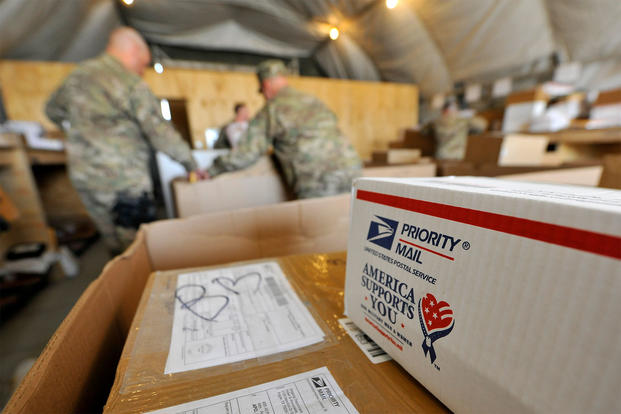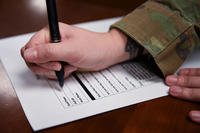Receiving a care package from home can be a real morale booster for a deployed service member. We’ve come a long way since the beginning of deployments to Iraq and Afghanistan in the early 2000s, and most service members deployed don’t need anything. But everyone loves to get mail!
Choosing and packing the contents of the package will also help you feel closer to your loved one. Your service member will undoubtedly appreciate anything you send, but some things are particularly useful -- and some items can't be sent at all. Before putting together your service member's care package, find out what they want, and check to see if there are restrictions on what you can send.
How to Send a Care Package
Know the timeline. Priority mail packages typically take about 10 to 14 days to reach their country of destination. But depending on where your service member is, more time may pass before the package is in his or her hands. When choosing what to send, keep in mind possible delays as well as any climate extremes the package may be subjected to.
Check on size and weight restrictions for packages. Packages cannot be larger than 108 inches in total circumference (total width all the way around plus total length all the way around), but your service member's unit may have its own restrictions on the weight and size of packages. These restrictions may change as the unit changes location. It's best to limit your care packages to the size of a shoebox. You can pick up free Priority Mail boxes at your post office. Use the #4 or #7 size box.
Include a list of contents. Enclose a card with the recipient's name and your name on the card. That way, if the package breaks open and the contents scatter during shipping, mail handlers will know what to repack.
Related: 7 Affordable Military Care Package Ideas
Prevent possible spills. Place items that may spill or leak in heavy plastic zipper-lock bags. Freezer bags work well and your service member will likely find other uses for the bags.
Use reusable packing material. Cushion fragile items with small packages of tissues; copies of the local newspaper; plastic zipper-lock bags filled with popped popcorn; small beanbag-style stuffed toys (for your service member to hand out to local children) or anything else you can think of that your service member will be able to use.
Write out the complete address. The address should include your service member's full name (with or without rank or rating), unit and APO/FPO (Air/Army Post Office or Fleet Post Office) address. Be sure you have the unit name, including the battalion, ship, squadron, platoon, etc., with the nine-digit ZIP code, if one is assigned.
Number your packages and letters. Some may take longer to arrive. Numbering them will alert your service member to letters and packages that are still on their way.
Keep the weather in mind. Don’t send perishables to warm climates during spring or summer. Avoid sending anything that may spoil to a desert environment such as Iraq during warm months. The climate heats up rapidly between winter and spring and the temperature inside mail storage facilities may rise to over 120 degrees.
Make sure you check holiday cut-off dates. If you are sending mail for the holidays, check for the shipping deadlines issued each year by the USPS so you can make sure your package gets there on time.
What Food or Drinks Can You Send?
Powdered drink mix. Your service member will appreciate anything that can be mixed with water. In cold months, send hot beverage mixes such as cocoa, instant coffee, tea bags and creamer. During warmer months, sweetened drink mixes such as lemonade and iced tea will be welcome.
Meal enhancers. Anything that can be mixed with MREs (Meals Ready to Eat), such as ramen noodles, seasoned salt, individual packets of hot sauce, mustard, relish and ketchup.
Related: Care Package Cake in a Jar How-To
Quick protein. Energy bars, tuna fish, sardines, non-perishable beef jerky or beef summer sausage. Make sure the meat is labeled USDA Beef.
Snacks. Look for small, hard containers of chips, pretzels and nuts. These are easier to carry than large containers. Avoid bags, which may burst under high pressure. If you do send large bags or containers, include small zipper-lock bags so your service member can pack smaller amounts of snacks to carry. Snack cakes, cheese crackers and cookies are in high demand. Salty snacks are good for those deployed in the desert, especially in the summer months, because they will encourage your service member to drink more water.
Candy and gum. Avoid chocolate if your service member is in a warm climate. It will melt in the heat. Gum and other types of candy may soften and become gooey, so send these in plastic zipper-lock bags. Send plenty of extras for your service member to share, especially if he or she comes into contact with children.
What do they Actually Need?
If you find your service member needs essentials, choose small, travel-size containers of personal care products, and avoid aerosol cans. To keep liquids from spilling, cover the opening of the container with plastic wrap, then recap before shipping.
Toiletries. Toothbrush, toothpaste, dental floss, cotton swabs, shaving lotion, disposable razors, shampoo, individually packaged tissues.
Personal care. Individually packaged baby wipes, eye drops, lip balm, lotion, aspirin or another pain reliever, feminine hygiene products for women.
Foot care. Moleskin, medicated foot powder and athletes foot ointment.
Disposable hand warmers. Send these during the winter if your service member is in a cold climate. Also, fingerless gloves, stocking caps and long underwear are good ideas.
Goggle-style sunglasses. Your service member will appreciate these if he or she is deployed in the desert.
Cotton socks and underwear. Make sure the garments are made of 100 percent cotton rather than a cotton blend.
Extra, Fun Things to Send
In every care package, be sure to include a personal note or other special reminders of home. Photographs, drawings, and DVDs of your activities at home will be comforting to your service member. Here are some more ideas:
- Your children's art projects or schoolwork.
- A small scrapbook filled with mementos from home.
- The Sunday comics from your local newspaper.
Additionally, some fun entertainment may be a good idea, especially if you have extra room in the flat-rate package.
Reading material. Paperback books, current magazines and comic books.
Games. Foam footballs and basketballs, Frisbees, Hacky Sacks, playing cards, yo-yos. Crossword puzzles, word searches, jigsaw puzzles.
Electronics. Portable media player, handheld electronic games. Maybe a disposable camera.
Batteries. Size AA and D batteries are in high demand. If you're sending a battery-operated device, remove the batteries so the appliance doesn't accidentally turn on during shipment. And remember: you cannot ship lithium-ion batteries.
Writing materials. Notepaper, envelopes, pens, pencils and stamps. Maybe even self-adressed stamped envelopes so you’re guaranteed to get something back.
Phone cards. Shop around to get the best deal on overseas minutes.
What can’t you send in a care package?
There may be items you cannot send, depending on where your service member is located. If your service member is in the Middle East or the Persian Gulf areas, you should not send anything that would offend people of the Islamic faith, including pork or pork by-products, obscene material, religious materials contrary to Islam, anything depicting nude or semi-nude persons, pornographic or sexual items, alcohol, or non-authorized political materials. Check with your Key Volunteer, Ombudsman or command family support group point of contact for details on further restrictions.
Keep Up with the Ins and Outs of Military Life
For the latest military news and tips on military family benefits and more, subscribe to Military.com and have the information you need delivered directly to your inbox.





















